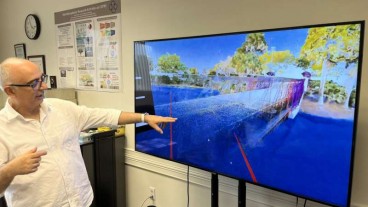PolyU unveils multi-tier AI bridge inspection system deployed on 11 Hong Kong bridges

A research team at The Hong Kong Polytechnic University has developed a multi-tier intelligent bridge inspection system that detects surface cracks and hidden structural flaws that are not visible to the human eye. The project is led by Prof. Tarek Zayed of PolyU’s Department of Building and Real Estate.
The system has been deployed across 11 local bridges. It integrates PolyU’s proprietary non-destructive testing technologies with advanced AI models, reducing inspection time by 50% and improving overall accuracy to 80%
The approach is designed to replace traditional visual inspection with three tools: drones for surface data capture, ground-penetrating radar to locate rebars and potential corrosion zones, and infrared thermography to identify deterioration such as spalling and delamination.
For surface crack detection, the team uses a drone-enabled visual inspection workflow and a self-developed deep convolutional neural network model, Smart Bridge Deck Efficiency (SBDE). The model demonstrated superior crack identification in challenging conditions and reduced false positives compared with other leading object-detection models.
For subsurface assessment, the fully automated GPR interpretation model locates rebars with over 98% precision and maps potential corrosion zones using amplitude analysis and clustering, streamlining corrosion assessment.
For delamination and related deterioration, the team developed an optimum thermal gradient threshold (OTGT) system for infrared thermography, adjusting thresholds based on environmental conditions and automatically generating delamination maps.
The system standardizes inspection results with a five-point severity scale to facilitate diagnosis and prioritization of repairs. The team is exploring collaboration with relevant government departments and industry partners for regular inspections in Hong Kong.
The two-year project was supported by the Smart Traffic Fund. Findings have been published in journals including Construction and Building Materials, Automation in Construction, and Advanced Engineering Informatics.
Want to read more like this story?

Drones and AI can reduce risks in corroded bridges
Oct, 15, 2024 | NewsToday, corroded bridges pose significant safety risks, but advances in drone and AI technology are...

Bridge inspection using drone technology by NCDOT
Feb, 26, 2021 | NewsSetting one more example of the expanding use of drone technology for infrastructure monitoring, th...

Novel computing model can detect structural damage with no physical intervention
Jan, 31, 2024 | NewsResearchers from Drexel University in Pennsylvania have developed a system that is believed to effi...

AI and virtual reality to monitor the structural safety of buildings and bridges
Nov, 08, 2023 | NewsThe structural health and safety of a nation's bridges and buildings is crucial for preventing disa...

Engineers developing the framework of a three-level system of inspection
Aug, 05, 2021 | NewsAfter the devastating collapse of the Surfside condo which cost the life of at least 100 people in...

Researchers developed AI-based algorithms for real-time structural assessment of bridges
Sep, 13, 2023 | NewsBridges play a crucial role in India's infrastructure, with approximately 13,500 of them spread acr...

Wimborne: A new bridge will be constructed considering inspection findings of the existing bridge
Jul, 12, 2024 | NewsAfter a routine inspection, the footbridge in Wimborne was deemed unsafe, and officials have decide...

3-D model may be the answer to the U.S. bridge maintenance crisis
Feb, 20, 2015 | NewsWith nearly 70,000 bridges requiring repair works across the U.S. and an estimated cost of $70 billi...

Closure of I-40 bridge in Memphis after cracks appear
May, 26, 2021 | NewsThe Tennessee Department of Transportation (TDOT) released photos of a crack on the Hernando de S...
Trending

Spectacular interchanges around the world

New Release - STAAD.Pro 2024 - 2

ADINA 2025 for Structural WorkSuite

STAAD.Pro 2024 New Release

ADINA 2025 New Release!

6.1-magnitude earthquake hit Turkey: at least 22 injuries

Bridge collapse in Bihar’s Araria: Probe ordered for the structural failure

